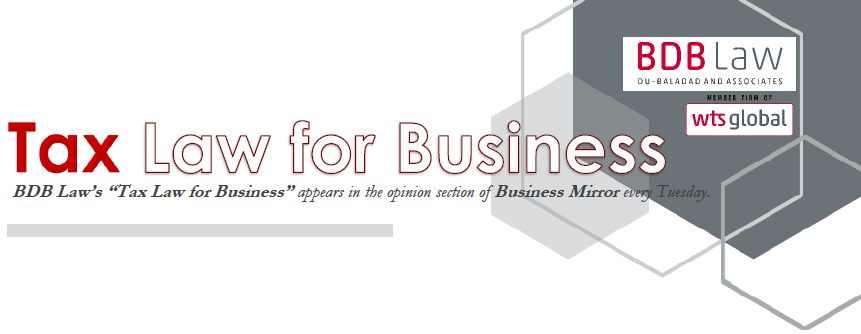
The 2022 OECD Transfer Pricing Guidelines (1ˢᵗ of 2 Parts)
By: Atty. Jomel N. Manaig
"While not being a member of the OECD, the Philippines, through the BIR, adheres to the OECD guidelines in principle. Even the BIR’s own TPG recognizes that it is largely based on the arm’s length methodologies as set out under the OECD TPG. Owing to the increasingly complex nature of transactions bearing equally complex tax issues, the OECD TPG continues to evolve through the issuance of new editions. The latest of these editions is the 2022 OECD TPG."
Moving with the unrelenting march of time and progress, the assimilation of different economic activities and integration of various business needs gave rise to issues relating to the artificial shifting of taxable profits and the increased risk of economic double taxation. Having this in mind, the Organization for Economic Cooperation and Development (“OECD”) issued the Transfer Pricing Guidelines (“TPG”) to provide the guidance on the application of the “arm’s length principle”. The TPG represents the international consensus on the valuation of transactions between associated enterprises.
While not being a member of the OECD, the Philippines, through the BIR, adheres to the OECD guidelines in principle. Even the BIR’s own TPG recognizes that it is largely based on the arm’s length methodologies as set out under the OECD TPG. Owing to the increasingly complex nature of transactions bearing equally complex tax issues, the OECD TPG continues to evolve through the issuance of new editions. The latest of these editions is the 2022 OECD TPG.
In this two-part article, we will explore the more significant changes adopted in the 2022 OECD TPG (as compared to its previous iteration, the 2017 OECD TPG), namely: (1) the revised guidelines on the Transactional Profit Split Method (“TPSM”); (2) guidelines on hard-to-value intangibles (“HTVI”); and (3) guidelines on financial transactions. For the first part, we will delve deeper into the guidelines regarding TPSM and HTVI.
 The TPSM is one of the transfer pricing methodologies adopted by the OECD. While the basic premise of TPSM remains unchanged, the revision expanded the underlying principles on how it may be considered as the most appropriate method to be used. While the lack of available comparables is, by itself, insufficient to warrant the use of TPSM, if reliable comparables are available then it is unlikely that TPSM will be the most appropriate.
The TPSM is one of the transfer pricing methodologies adopted by the OECD. While the basic premise of TPSM remains unchanged, the revision expanded the underlying principles on how it may be considered as the most appropriate method to be used. While the lack of available comparables is, by itself, insufficient to warrant the use of TPSM, if reliable comparables are available then it is unlikely that TPSM will be the most appropriate.
The main strength of TPSM is that it can offer a solution for cases where both parties to a transaction make unique and valuable contributions to the transaction. Consequently, the allocation of profits under the TPSM may be based on the contributions made by the associated enterprises. In determining the applicability of the TPSM, an accurate delineation of the actual transaction is important. Some factors which offer an indication that the TPSM may be considered as the most appropriate transfer pricing method are: (1) the existence of unique and valuable contributions by each of the parties to the transaction; (2) the presence of highly integrated business operations; and (3) the shared assumption of economically significant risks and separate assumption of closely-related risks.
The revisions also dealt with the recommended approaches to splitting profits such as the contribution analysis and the residual analysis. Examples of profit splitting factors, such as the asset-based profit splitting factors and the cost-based profit splitting factors, were likewise given attention.
Aside from the revised guidelines on TPSM, the 2022 OECD TPG also gave way to the guidelines on HTVI which are aimed at preventing base erosion and profit shifting by moving intangibles among group members. An HTVI is an intangible, whereby at the time of its transfer: (1) there are no existing reliable comparables; and (2) the projections of future cash flow or income are highly uncertain.
The recommended HTVI approach under the 2022 OECD TPG protects tax administrations from the negative effects of information asymmetry by ensuring that tax administrations can consider ex post outcomes as presumptive evidence about the appropriateness of the ex ante pricing arrangements. However, the ex post evidence should not be used without considering whether the information on which the ex post results are based could or should reasonably have been considered by the associated enterprises at the time the transaction was entered into. Thereafter, the taxpayer has the opportunity to rebut such presumptive evidence by demonstrating the reliability of the information supporting the pricing methodology adopted at the time the controlled transaction took place.
In addition, in the event that the application of the HTVI approach leads to double taxation, the guidelines provide that it is important to permit resolution of such issue through access to the Mutual Agreement Procedure under the applicable tax treaty.
For the second part of this article, we will go for a closer look at the transfer pricing aspects of financial transactions to wrap-up the major changes in the 2022 OECD TPG.
The author is a junior partner of Du-Baladad and Associates Law Offices (BDB Law), a member-firm of WTS Global.
The article is for general information only and is not intended, nor should be construed as a substitute for tax, legal or financial advice on any specific matter. Applicability of this article to any actual or particular tax or legal issue should be supported therefore by a professional study or advice. If you have any comments or questions concerning the article, you may e-mail the author at This email address is being protected from spambots. You need JavaScript enabled to view it. or call 8403-2001 local 380.




